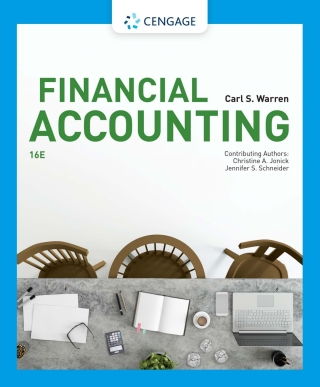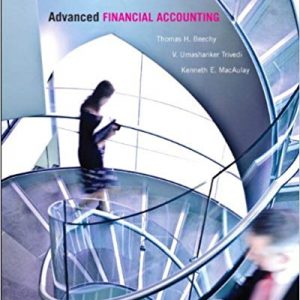Buy Financial Accounting, 16th Edition PDF ebook by author Carl S. Warren; Christine Jonick; Jennifer Schneider – published by Cengage Learning in 2021 and save up to 80% compared to the print version of this textbook. With PDF version of this textbook, not only save you money, you can also highlight, add text, underline add post-it notes, bookmarks to pages, instantly search for the major terms or chapter titles, etc.
You can search our site for other versions of the Financial Accounting, 16th Edition PDF ebook. You can also search for others PDF ebooks from publisher Cengage Learning, as well as from your favorite authors. We have thousands of online textbooks and course materials (mostly in PDF) that you can download immediately after purchase.
Note: e-textBooks do not come with access codes, CDs/DVDs, workbooks, and other supplemental items.
eBook Details:
Full title: Financial Accounting, 16th Edition
Edition: 16th
Copyright year: 2021
Publisher: Cengage Learning
Author: Carl S. Warren; Christine Jonick; Jennifer Schneider
ISBN: 9781337913102, 9781337913263
Format: PDF
Description of Financial Accounting, 16th Edition:
Discover the strong foundation in financial accounting to prepare you for future study and success in today’s business world with Warren/Jonick/Schneider’s leading FINANCIAL ACCOUNTING, 16E. This edition connects financial accounting concepts to the “”bigger picture”” within accounting as chapter-opening schemas demonstrate how each chapter’s content fits within the overall framework of the book. The authors also clearly illustrate the impact of transactions on the accounting equation. This book’s hallmark presentation of the accounting cycle provides an unmatched foundation for later chapters and even upcoming coursework and your career. Streamlined content and improved learning features throughout this edition ensure you have a solid understanding of today’s financial accounting and the specific tools you need to succeed.Important Notice: Media content referenced within the product description or the product text may not be available in the ebook version.
Table of Contents of Financial Accounting, 16th Edition PDF ebook:
Brief ContentsPrefaceAbout the AuthorsContentsChapter 1: Introduction to Accounting and BusinessNature of Business and AccountingGenerally Accepted Accounting PrinciplesThe Accounting EquationBusiness Transactions and the Accounting EquationFinancial StatementsFinancial Analysis and Interpretation: Ratio of Liabilities to Owner’s EquityAt a Glance 1Illustrative ProblemKey TermsDiscussion QuestionsPractice ExercisesExercisesProblems: Series AProblems: Series BContinuing ProblemCases & ProjectsChapter 2: Analyzing TransactionsUsing Accounts to Record TransactionsDouble-Entry Accounting SystemJournalizing and Posting to AccountsTrial BalanceFinancial Analysis and Interpretation: Horizontal AnalysisAt a Glance 2Illustrative ProblemKey TermsDiscussion QuestionsPractice ExercisesExercisesProblems: Series AProblems: Series BContinuing ProblemCases & ProjectsChapter 3: The Adjusting ProcessNature of the Adjusting ProcessAdjusting Entries for AccrualsAdjusting Entries for DeferralsAdjusting Entries for DepreciationSummary of Adjusting ProcessAdjusted Trial BalanceFinancial Analysis and Interpretation: Vertical AnalysisAt a Glance 3Illustrative ProblemKey TermsDiscussion QuestionsPractice ExercisesExercisesProblems: Series AProblems: Series BContinuing ProblemCases & ProjectsChapter 4: Completing the Accounting CycleFlow of Accounting InformationFinancial StatementsClosing EntriesAccounting CycleIllustration of the Accounting CycleFinancial Analysis and Interpretation: Working Capital and Current RatioAppendix 1: End-of-Period SpreadsheetAppendix 2: Why Is the Accrual Basis of Accounting Required by GAAP?At a Glance 4Illustrative ProblemKey TermsDiscussion QuestionsPractice ExercisesExercisesProblems: Series AProblems: Series BContinuing ProblemComprehensive Problem 1Cases & ProjectsChapter 5: Accounting SystemsBasic Accounting SystemsManual Accounting SystemsComputerized Accounting SystemsE-CommerceFinancial Analysis and Interpretation: Segment AnalysisAt a Glance 5Illustrative ProblemKey TermsDiscussion QuestionsPractice ExercisesExercisesProblems: Series AProblems: Series BCases & ProjectsChapter 6: Accounting for Merchandising BusinessesNature of Merchandising BusinessesMerchandising TransactionsThe Adjusting ProcessFinancial Statements for a Merchandising BusinessFinancial Analysis and Interpretation: Asset TurnoverAppendix 1: Gross Method of Recording Sales DiscountsAdjusting EntrySubsequent PeriodAppendix 2: Returns of MerchandiseAppendix 3: The Periodic Inventory SystemAt a Glance 6Illustrative ProblemKey TermsDiscussion QuestionsPractice ExercisesExercisesProblems: Series AProblems: Series BComprehensive Problem 2Cases & ProjectsChapter 7: InventoriesControl of InventoryInventory Cost Flow AssumptionsInventory Costing Methods under a Perpetual Inventory SystemInventory Costing Methods under a Periodic Inventory SystemComparing Inventory Costing MethodsReporting Merchandise Inventory in the Financial StatementsFinancial Analysis and Interpretation: Inventory Turnover and Days’ Sales in InventoryAppendix: Estimating Inventory CostAt a Glance 7Illustrative ProblemKey TermsDiscussion QuestionsPractice ExercisesExercisesProblems: Series AProblems: Series BCases & ProjectsChapter 8: Internal Control and CashSarbanes-Oxley ActInternal ControlCash Controls over Receipts and PaymentsBank AccountsBank ReconciliationSpecial-Purpose Cash FundsFinancial Statement Reporting of CashFinancial Analysis and Interpretation: Ratio of Cash to Monthly Cash ExpensesAt a Glance 8Illustrative ProblemKey TermsDiscussion QuestionsPractice ExercisesExercisesProblems: Series AProblems: Series BCases & ProjectsChapter 9: ReceivablesClassification of ReceivablesUncollectible ReceivablesDirect Write-Off Method for Uncollectible AccountsAllowance Method for Uncollectible AccountsComparing Direct Write-Off and Allowance MethodsNotes ReceivableReporting Receivables on the Balance SheetFinancial Analysis and Interpretation: Accounts Receivable Turnover and Days’ Sales in ReceivablesAt a Glance 9Illustrative ProblemKey TermsDiscussion QuestionsPractice ExercisesExercisesProblems: Series AProblems: Series BCases & ProjectsChapter 10: Long-Term Assets: Fixed and IntangibleNature of Fixed AssetsAccounting for DepreciationDisposal of Fixed AssetsNatural ResourcesIntangible AssetsFinancial Reporting for Long-Term Assets: Fixed and IntangibleFinancial Analysis and Interpretation: Fixed Asset Turnover RatioAppendix: Exchanging Similar Fixed AssetsAt a Glance 10Illustrative ProblemKey TermsDiscussion QuestionsPractice ExercisesExercisesProblems: Series AProblems: Series BCases & ProjectsChapter 11: Current Liabilities and PayrollCurrent LiabilitiesPayroll and Payroll TaxesAccounting Systems for Payroll and Payroll TaxesEmployees’ Fringe BenefitsContingent LiabilitiesFinancial Analysis and Interpretation: Quick RatioAt a Glance 11Illustrative ProblemKey TermsDiscussion QuestionsPractice ExercisesExercisesProblems: Series AProblems: Series BComprehensive Problem 3Cases & ProjectsChapter 12: Accounting for Partnerships and Limited Liability CompaniesProprietorships, Partnerships, and Limited Liability CompaniesForming a Partnership and Dividing IncomePartner Admission and WithdrawalLiquidating PartnershipsStatement of Partnership EquityFinancial Analysis and Interpretation: Revenue per EmployeeAt a Glance 12Illustrative ProblemKey TermsDiscussion QuestionsPractice ExercisesExercisesProblems: Series AProblems: Series BCases & ProjectsChapter 13: Corporations: Organization, Stock Transactions, and DividendsNature of a CorporationStockholders’ EquityPaid-In Capital from StockAccounting for DividendsStock SplitsTreasury Stock TransactionsReporting Stockholders’ EquityFinancial Analysis and Interpretation: Earnings per ShareAt a Glance 13Illustrative ProblemKey TermsDiscussion QuestionsPractice ExercisesExercisesProblems: Series AProblems: Series BCases & ProjectsChapter 14: Long-Term Liabilities: Bonds and NotesFinancing CorporationsNature of Bonds PayableAccounting for Bonds PayableInstallment NotesReporting Long-Term LiabilitiesFinancial Analysis and Interpretation: Times Interest Earned RatioAppendix 1: Present Value Concepts and Pricing Bonds PayableAppendix 2: Interest Rate Method of AmortizationAt a Glance 14Illustrative ProblemKey TermsDiscussion QuestionsPractice ExercisesExercisesProblems: Series AProblems: Series BCases & ProjectsChapter 15: InvestmentsWhy Companies InvestEquity InvestmentsHeld-to-Maturity InvestmentsTrading and Available-for-Sale InvestmentsFinancial Analysis and Interpretation: Dividend YieldAppendix: Comprehensive IncomeAt a Glance 15Illustrative ProblemKey TermsDiscussion QuestionsPractice ExercisesExercisesProblems: Series AProblems: Series BComprehensive Problem 4Cases & ProjectsChapter 16: Statement of Cash FlowsReporting Cash FlowsCash Flows from (Used for) Operating ActivitiesCash Flows from (Used for) Investing ActivitiesCash Flows from (Used for) Financing ActivitiesPrepare a Statement of Cash Flows-Indirect MethodFinancial Analysis and Interpretation: Free Cash FlowAppendix 1: Spreadsheet (Work Sheet) for Statement of Cash Flows-The Indirect MethodAppendix 2: Preparing the Statement of Cash Flows-The Direct MethodAt a Glance 16Illustrative ProblemKey TermsDiscussion QuestionsPractice ExercisesExercisesProblems: Series AProblems: Series BCases & ProjectsChapter 17: Financial Statement AnalysisAnalyzing and Interpreting Financial StatementsBasic Analytical MethodsAnalyzing LiquidityAnalyzing SolvencyAnalyzing ProfitabilityCorporate Annual ReportsAppendix: Unusual Items on the Income StatementAt a Glance 17Illustrative ProblemKey TermsDiscussion QuestionsPractice ExercisesExercisesProblems: Series AProblems: Series BNike, Inc., ProblemCases & ProjectsFinancial Statements for Mornin’ JoeAppendix A: Interest TablesAppendix B: Revenue RecognitionAppendix C: Selected Excerpts from Nike Inc., Form 10-K for the Fiscal Year Ended May 31, 2018GlossaryIndex





